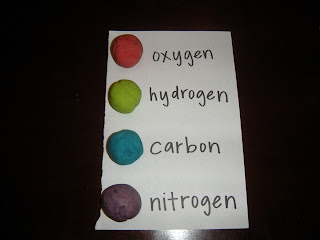The following Pictures show Molecular Structures of Water, Ammonia, and Aspirin. The Picture below shows a Kekule image of Aspirin. Aspirin's IUPAC name is Acetylsalicylic Acid.
Question #2 Image, systematic IUPAC name, common name, and molecule formula for common household items.
1. Talcum Powder, Hydrated Magnesium Silicate, Baby Powder, H2Mg3(SiO3)4 or Mg3Si4O10(OH)2.
2. Glucose, D-Glucose, C6H12O6
3. Sugar, Sucrose,C12,H22O11
4. Acetone, Dimethyl Ketone, Finger Nail Polish Remover, C3H6O
5. Alum,Aluminum Potassium Sulfate, KAI(SO4)2
6. Aspirin, Acetylsalicylic Acid, C9H8O4
7. Baking Soda, Sodium Bicarbonate, NaHCO3
8. Chalk, Calcium Sulfate, CaCO3
9.Cream of Tartar, Potassium Bitartrate, KC4H5O6
10. Diamond, Carbon Crystal, the chemical formula for diamond is C.
11. Epsom Salts, Magnesium Sulfate, also known as bath salts, MgSO4

12. Gypsum, Natural Calcium Sulfate, Building material (can be found in plaster), CaSO4+2(H2O)
13.Laughing Gas, Nitrous Oxide, N2O
14. Marble, Mainly Calcium Carbonate, CaCO3
15. Plaster of Paris, Calcium Sulfate, used for molds, CaSO4
16. Rock Salt, Sodium Chloride, NaCl
17. Rubbing Alcohol, Isopropyl Alcohol, used for cuts and nail polish remover, C3H8O
18.Table Salt, Sodium Chloride, NaCl
19. Soda Ash, Sodium Carbonate, used for glassmaking, Na2CO3
20.Vitamin C, Ascorbic Acid, C6H8O6
Question #3. How many bonds can each make:
Hydrogen: can bond with 1
Oxygen: can bond with 2
Carbon: can bond with 4
Nitrogen: can bond with 3
Phosphorous: can bond with 3
Sulfur: can bond with 2
Question #4 What does IUPAC stand for?
The International Union of Pure and Applied Chemistry
#5 After searching on the web for the ingredients in the Green Aussie cleaners I found it very difficult to find their ingredients. I also searched other natural cleaners and found it to be the same way. When companies say they are all natural, they do a very good job of keeping those "extra" ingredients secret or hard to find. However, I found a web page that described what companies mean when they say natural. This website http://www.healthycleaning101.org/english/QA.html says that natural products come from the earth or can be found in nature but nothing is extracted from the earth without being processed with materials that perform a cleaning function. Many products that say they are natural are referring to the surfactant in the product. Surfactants reduce the surface water of tension and almost all cleaning products use them. Surfactants are made from petrochemicals (crude oil or natural gas) or oleochemicals (fats and oils). So whether the cleaning companies want to share with us the chemicals that they use we at least know that Natural does not actually mean completly natural! =)





No comments:
Post a Comment